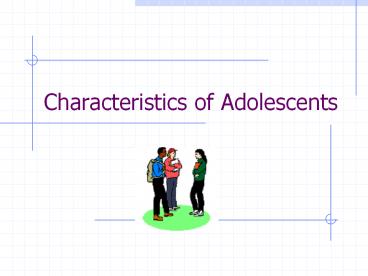Characteristics of Adolescents - PowerPoint PPT Presentation
Title:
Characteristics of Adolescents
Description:
Conformity with 'in' styles such as clothing and hair style. ... Relate intellectual activities with immediate and short-range goals. ... – PowerPoint PPT presentation
Number of Views:3276
Avg rating:3.0/5.0
Title: Characteristics of Adolescents
1
Characteristics of Adolescents
2
Developmental Transitions
- Biological spurs changes in how adolescents are
viewed and treated by their parents and peers,
and how adolescents view and feel about
themselves. - Cognitive crossing from childlike thinking to
adult thinking - Social parents become less important and peers
become more important
3
Biological Changes - Puberty
- Growth occurs
- Body composition begins to change.
- The circulatory and respiratory systems begin to
change. - The primary sex characteristics develop.
- The secondary sex characteristics develop.
4
Biological Changes - Hormones
- Higher hormone levels during puberty are related
to greater moodiness, in the form of anger and
irritability for males and anger and depression
for females, between nine and fourteen years of
age - These effects may be greatest when the endocrine
system is being turned on
5
In relation to body development, appearance, and
activity students of middle school age exhibit
- Increased interest in the physical aspects of the
body, including its functions and changes. - Generally rapid, though irregular, physical
development with resultant differences among
peers due to uneven growth and development. - Generally a more advanced physical maturity on
the part of girls than of boys at the same
chronological age. - Awkward and clumsy movements due to bone growth
preceding muscle growth. - Considerable attention to personal appearance and
concern with irregularities such as skin
blemishes, scars, and obesity. - Conformity with "in" styles such as clothing and
hair style. - Extreme restlessness with great need to release
physical energy. - Talkativeness.
- Responsiveness to a variety of non structured and
leisure activities.
6
Cognitive Development - Piaget
- The first stage is referred to as the
sensorimotor stage. - The second stage was named the preoperational
stage. - The third stage is named the concrete operations
stage - The last stage in Piaget's theory is the formal
operations stage
7
In relation to their intellectual experiences,
students of middle school age tend to
- Be curious and inquisitive.
- Prefer active over passive learning activities.
- Relate intellectual activities with immediate and
short-range goals. - Prefer interaction with peers. during learning
activities. - Desire opportunities to express originality on an
individual basis. - Be interested in both concrete and abstract
exercises, and be more able to deal with abstract
concerts than formerly. - Desire opportunities to participate in practical
problem-solving situations. - Show interest in races and cultures other than
their own. - Challenge "idealistic" teaching.
- Be interested in making fuller utilization of
basic skills used in the elementary school. - Evaluate personal capabilities, both attributes
and limitations. - Show strong intense interests, not always
sustained, in various pursuits.
8
Social Development
- Begin to take interest in opposite sex and dating
- gender identity is formed through media, school
and most importantly, their parents - Shift in parental/peer influence roles
- Increase in personal autonomy
9
With their concern for individuality, conformity,
and development of values, students of middle
school age evidence
- A desire to be "different," yet , within the
overall limits of peer conformity. - A desire for opportunities to exercise
selectivity in the choice of food, activities,
and friends--with frequent changes in "close"
friendships. - Considerable peer consciousness strong need for
a feeling of belonging to a group. - An adherence to peer group standards along with
an awareness of "acceptable behavior". - A concern for "right", "wrong", and "social
justice". - A concern for less fortunate "others" .
- Attempts to identify with adults other than
parents.
10
In relation to their uncertainties and conflicts,
students of middle school age tend to
- Be frequently impulsive with words and actions
impatient to get things done in a hurry. - Have ambivalent desires want freedom, but fear
the loss of certain securities. - Become more independent, yet still feel the need
for direction and regulation. - A desire to make their own evaluation of
suggestions from others. - Exhibit a ,wide range of overt behaviors and mood
instability quiet-loud, shy-boisterous,
fearful-confident, anxious-assured. - Need experience with frequent success and desire
attention and recognition for personal efforts
and achievements. - Seek approval of and acceptance by adults.
- Be sensitive to criticism of personal
short-comings and often easily offended. - Be anxious, doubtful, and confused about their
physical and intellectual development, social
relationships, and adult authority.
11
Sources
- Boeree, G. (2000). Jean Piaget. Retrieved from
http//www.ship.edu/cgboeree/piaget.html - http//www.aas.ru/Academics/counselor/teach/needs.
html Michael F. Tobin, Consultant for Elementary
Education, Connecticut Department of Education,
Hartford






























